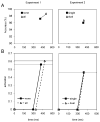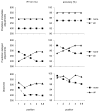Proactive adjustments of response strategies in the stop-signal paradigm
- PMID: 19485695
- PMCID: PMC2690716
- DOI: 10.1037/a0012726
Proactive adjustments of response strategies in the stop-signal paradigm
Abstract
In the stop-signal paradigm, fast responses are harder to inhibit than slow responses, so subjects must balance speed in the go task with successful stopping in the stop task. In theory, subjects achieve this balance by adjusting response thresholds for the go task, making proactive adjustments in response to instructions that indicate that relevant stop signals are likely to occur. The 5 experiments reported here tested this theoretical claim, presenting cues that indicated whether or not stop signals were relevant for the next few trials. Subjects made proactive response-strategy adjustments in each experiment: Diffusion-model fits showed that response threshold increased when participants expected stop signals to occur, slowing go responses and increasing accuracy. Furthermore, the results show that subjects can make proactive response-strategy adjustments on a trial-by-trial basis, suggesting a flexible cognitive system that can proactively adjust itself in changing environments.
(c) 2009 APA, all rights reserved.
Figures









References
-
- Baddeley A. Exploring the central executive. Quarterly Journal of Experimental Psychology. 1996;49A:5–28.
-
- Band GPH, van der Molen MW, Logan GD. Horse-race model simulations of the stop-signal procedure. Acta Psychologica. 2003;112:105–142. - PubMed
-
- Bedard AC, Nichols S, Barbosa JA, Schachar R, Logan GD, Tannock R. The development of selective inhibitory control across the life span. Developmental Neuropsychology. 2002;21:93–111. - PubMed
-
- Botvinick MM, Braver TS, Barch DM, Carter CS, Cohen JD. Conflict monitoring and cognitive control. Psychological Review. 2001;108:624–652. - PubMed

